Re-greening the desert: Seawater for agriculture in Somaliland
The idea of re-greening the desert and transforming it into productive agricultural land has existed for a long time. In the Horn of Africa, historically dominant rain-fed subsistence agriculture has given way to the building of dams and extending mechanized sweet water irrigation systems. The latter have become the main strategies to expand the productive land under cultivation. This has implied the transfer of land ownership from traditional subsistence farmers to companies and corporations engaging in large-scale agriculture ventures.
More recently, the technology to convert sea water into sweet water has allowed the expansion of agriculture to certain drylands. However, this technology has been very expensive and has required concentration on the production of high-value vegetables the location of the farms to be near consumers interested in buying such products. These factors have limited the success and the practical range possibilities of the conversion technology to certain regions, such as parts of the Middle East and Australia.
Yet, new developments in technology have allowed the experimentation of seawater desalination farming in less privileged dry areas. One such area is the Horn of Africa. At the moment, one foreign company is testing its new technology in drylands of Somaliland’ Berbera. The attempt is to come up with solutions that are durable, affordable, and more cost-effective than before. After a number of years’ groundwork, the first seawater greenhouse was installed in Somaliland in October 2017 and is already operational.
The technology employed combines desalination and evaporative cooling. If the production and operational costs are kept low, and the equipment endures the harsh environmental conditions of the Horn of Africa’s drylands, it will have great potential for converting the unproductive desert into productive farmland. Due to the low requirement of land area necessary for successful production, the new technology may allow small farmers and co-operatives to remain productive and has some potential for keeping large companies engaging in agribusiness at bay. In the near future, seawater desalination agriculture may become a revolutionary development in the Horn of Africa sub-region which often suffers from prolonged periods of drought and food shortages.
For more information on the Seawater Greenhouse-Somaliland project, visit https://www.sgsomaliland.com/
Somaliland desert. Photo by YoTuT / CC BY 2.0
![]() This work is licensed under a Creative Commons Attribution-NonCommercial-ShareAlike 4.0 International License.
This work is licensed under a Creative Commons Attribution-NonCommercial-ShareAlike 4.0 International License.




